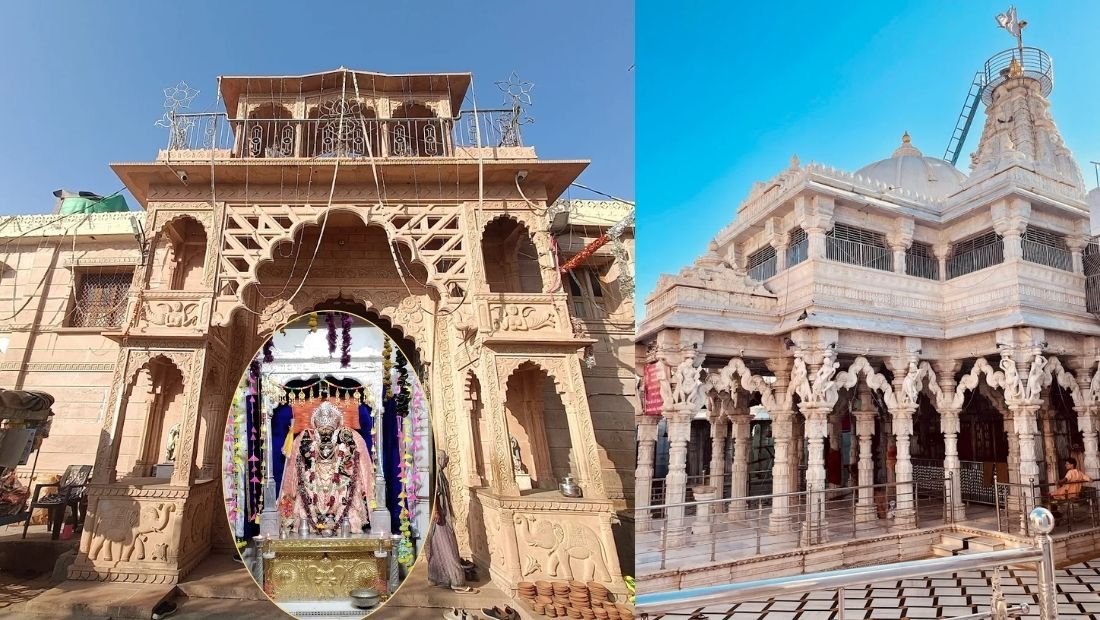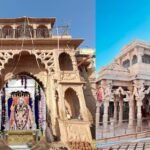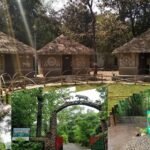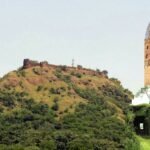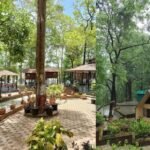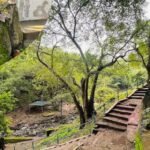Dharanidhar Bhagwan Temple Dhima is a sacred landmark in Gujarat’s Banaskantha district, offering a divine blend of devotion, mythology, and miracles.
Nestled in the spiritually vibrant village of Dhima, this ancient shrine dedicated to Avinashi (eternal) Vishnu Bhagwan is more than just a temple — it is a beacon of faith and wonder. Revered as one of the most powerful and rare Krishna temples, the Dharanidhar Mandir stands as a central pilgrimage destination not just for Vav Taluka, but for all of North Gujarat.
🌼 Dharanidhar Bhagwan – Glimpses of a Mini Dwarka
The temple, approximately 600 years old, is dedicated to Lord Krishna in his Dharanidhar form. It features a rare Moochhala (mustached) Krishna idol — a unique form not found elsewhere in India. Devotion, peace, and divine presence are profoundly felt within the temple.
🌸 Mythological Significance and Folklore
Ancient inscriptions and local devotees believe that in the 12th century, this site housed a temple of Varaha Bhagwan (the Boar incarnation of Vishnu). It is said that the Lord saved his devotees from dire circumstances through divine intervention. Locals believe that Lord Vishnu personally manifested at this site, initiating this sacred pilgrimage over six centuries ago.
🛕 Religious Importance and Spiritual Magnetism
After Ambaji, this is considered the most significant pilgrimage site in North Gujarat, often referred to as a “Mini Dwarka”. Every full moon, a large religious fair is held here, where thousands of devotees arrive to seek the blessings of Dharanidhar Bhagwan. The village resonates with the sounds of bhajans, kirtans, and devotional hymns.
History and Legends of Dharanidhar Temple
Folklore suggests that centuries ago, the site featured a beautiful temple of Varaha Bhagwan. In 1353 CE, Alauddin Khilji attacked and desecrated the idol. From the broken Varaha idol, a Shivling emerged, which is still present in the temple complex.
When the invader tried to desecrate the idol of Nag Devta (Dheeman Nagdada), a swarm of bees erupted from the temple and forced the attackers to retreat. This led to the saying:
“Dheema Dheeman Nag, Dhagdho Dhalo Karyo, Upar Aavyo Asur Harine Pachho Faryo.“
For 125 years after the Varaha idol was destroyed, its empty throne was still worshipped. During that period, Dheema village flourished with 18 castes living in harmony. Among them was a devout farmer named Ruda Bhagat (Karad Patel).
One night, Dharanidhar Bhagwan appeared in Ruda Bhagat’s dream and said:
“O dear devotee, listen! I, the dark one (Shamala), reside in the hills of Vasavada. When your cow gives birth to twin calves with sandalwood tilak on their foreheads, bring them with you and come find me.”
The dream came true, and when the calves were six months old, Ruda and his friend Gadadhar set out with bullocks toward the hills of Vasavada. They searched tirelessly but found nothing. That night, while resting in the jungle, the Lord appeared again in a dream:
“Walk 125 steps east from where you’re sleeping. Move a stone slab — I reside beneath it.”
They did exactly that, and miraculously discovered the divine idol of Shamala Bhagwan. Though large in size, the idol became light and movable at the devotees’ humble request. They carried it back in a bullock cart.
When they passed through Shihori, the local king demanded that they pay the idol’s weight in gold. Distressed, Ruda Bhagat prayed — the Lord instructed:
“Place the golden earring (thansio) from your ear on the scale.”
As instructed, Ruda placed the thansio, and the scales immediately balanced! Amazed by this miracle, the king allowed them to continue their journey to Dheema with royal escorts.
On the auspicious day of Jeth Sud Ekadashi, Samvat 1477 (1421 CE), the idol of Dharanidhar Bhagwan was ceremoniously installed in Dheema.
🙏 Living Traditions: The Legacy of Ruda Bhagat
To this day, the Karad Patel family continues the service of Dharanidhar Bhagwan with utmost devotion. Every Ram Navami, members of the family must visit the temple to perform the sacred saffron sprinkling (kesar chhatak) ritual. On that day, the Brahmin priest dresses in traditional Karad attire (kadiyu) and performs the puja. This tradition remains unbroken and deeply respected.
Before his death, Ruda Bhagat humbly prayed to the Lord:
“If my descendants cannot maintain this level of devotion, may my lineage not multiply within Dheema.”
The Lord granted this wish. As a result, only one unbroken Karad family line exists in Dheema to this day. Others have migrated to nearby villages like Ajawada and Karbun, fearing the continuation of the curse. Yet they all revere Dharanidhar Bhagwan as their family deity (kuldev).
⛩️ Temples Within the Dharanidhar Complex
The 600-year-old temple complex houses shrines of:
- Mahadev (Shiva)
- Lakshmi Mata
- Ganpati
- Hanumanji
- Kartikeya
- Riddhi-Siddhi
- Bhairavnath Dada
- Varahi Mata
- Markandeya Rishi — whose meditation site (tapobhumi) is still venerated by devotees.
Every Jeth Sud Ekadashi, a grand festival is held to celebrate the divine anniversary (Patotsav) of the temple.
📜 Folktales and Miraculous Beliefs
🕉️ The Tapobhumi of Rishi Markandeya
Beside the main temple lies a sacred pond, once the site of a seven-story stepwell. It is believed that Rishi Markandeya performed intense penance here. This site is still known as his divine meditation ground.
🌊 The Tale of Madela Talav (Pond)
A devotee named Mahadev Vanjara visited Dharanidhar with donkeys and prayed for a son and healing from leprosy. In return, he vowed to build a pond. The Lord fulfilled his wish, and he later constructed the pond now known as Madela Talav.
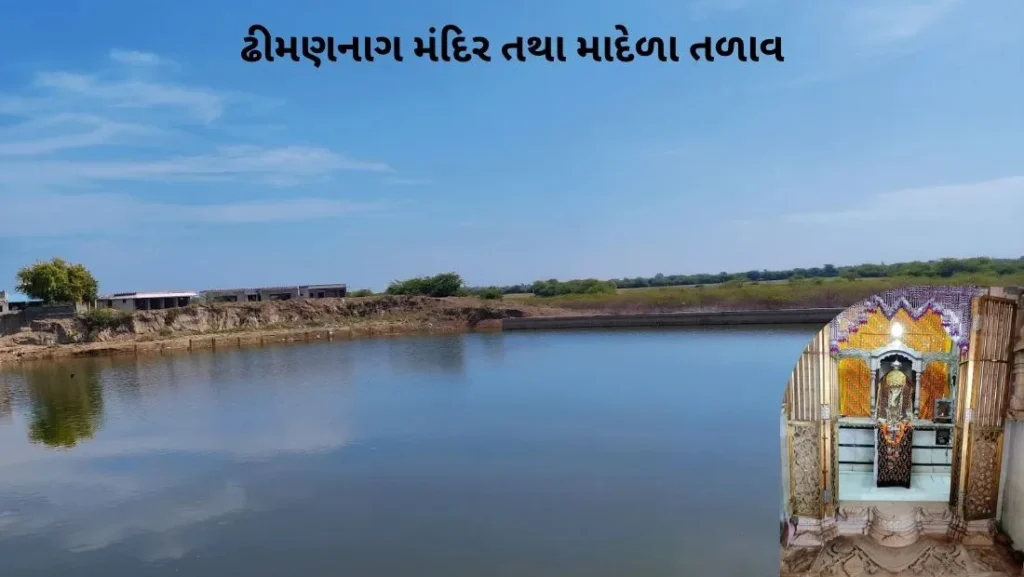
🌿 A Center of Peace, Faith, and Spiritual Renewal
Dharanidhar Mandir is not just a temple — it’s a place of inner transformation. Devotees leave behind their sorrows and worries here, finding spiritual peace and renewed strength. It is said that:
A pilgrimage to the four holy dhams is incomplete without visiting Dharanidhar Bhagwan.
🚗 How to Reach Dharanidhar Mandir – Dheema
📍 Location: Dheema Village, Vav Taluka, Banaskantha District, North Gujarat
🛣️ By Road:
- Nearest Towns: Vav (~12 km), Tharad (~35 km)
- From Palanpur: ~95 km via private vehicle or GSRTC buses
🚌 By Bus:
- Regular GSRTC buses run from Vav and Tharad to Dheema
- Local tempos and shuttle services are also available from Vav
🚆 By Train:
- Nearest Stations: Deesa (~60 km), Palanpur (~95 km)
- Taxis or buses are available from both stations
✈️ By Air:
- Nearest Airport: Ahmedabad (~200 km)
- Route: Ahmedabad → Palanpur → Tharad/Vav → Dheema
🛏️ Accommodation & Food
🕉️ Stay:
- Basic lodging facilities are available within the temple premises, especially during festivals
- Nearby dharamshalas or guesthouses also offer night stays
🍛 Food:
- Prasad and simple meals are served at the temple
- During festivals, community meals (annakshetra) are organized for devotees
🌿 Nearby Attractions
- 🛕 Ambaji Temple – ~90 km, one of Gujarat’s major Shaktipeeths
- 🌄 Nadabet & Nadeshwari Mata Mandir – ~60 km
- 🛕 Muleshwar Mahadev, Padan – ~40 km
- 🕉️ Gela Hanuman Mandir – ~35 km
🙏 Visit With Devotion…
Dharanidhar Mandir is not just a religious site — it’s a spiritual journey that connects you to your inner self. A visit to this miraculous abode of Lord Krishna brings peace, devotion, and divine energy.
No pilgrimage is truly complete without the darshan of Dharanidhar Bhagwan.
